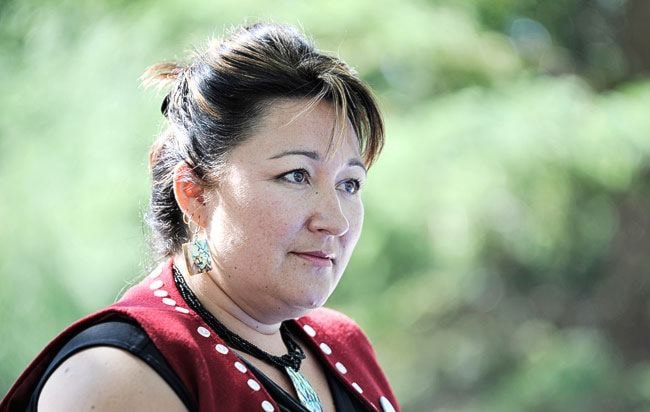At the fifth annual Yukon First Nations Resource Conference in Whitehorse this week, the emphasis was on partnerships and communication.
The two-day conference, which took place Wednesday and Thursday, featured panel sessions with titles like “Working Together to Explore for More,” “Project Certainty through Respectful, Honest and Trusting Relations,” and “Mining: An Economic Opportunity for First Nations.”
Set against the backdrop of ongoing First Nations lawsuits against the Yukon government over mining-related issues, the pitch was clear: engaging respectfully with First Nations can be a net good for the industry, and mining can also be a boon for those First Nations that embrace it.
The final session of the conference, “Advancing Projects and Partnerships,” featured Chief Math’ieya Alatini of the Kluane First Nation as well as representatives from Kaminak Gold Corp. and Wellgreen Platinum.
Allison Rippin Armstrong, director of lands and environment for Kaminak, spoke from an industry perspective about the hows and whys of engaging with First Nations. She argued that exploration companies should not just inform First Nations about their projects and plans, but also listen and ask questions - about wildlife movements, culturally significant sites, and other sensitive areas that can derail a project.
She suggested that open communication, environmental monitoring, cultural significance studies and even reclamation studies should begin before the project begins to have any impact on the land - not after.
By working closely with First Nations and local communities from the outset, she said, “you improve the likelihood of successful and timely permitting. You have a true partnership going into the construction of your project.”
Chief Alatini spoke next, explaining that her drive to engage actively with the industry was a result of her election in 2010, in the midst of an enormous staking rush. The activity, she said, was overwhelming - so the KFN responded by gathering industry and First Nations experts and sitting down to analyze the First Nation’s capacity to provide services to industry, as well as its needs and how industry might be able to help meet them.
The KFN revived its then-defunct Kluane Development Corporation and also created a second institution, the Kluane Community Development Corporation - while the former would focus on wealth generation through tools like limited partnerships and investments, the latter would provide support to local businesses and help to create support services for industry.
The most notable project on KFN land right now is Wellgreen Platinum, which is touted as one of the world’s largest undeveloped deposits of platinum and its related group of metals. Located just off the Alaska Highway north of Burwash Landing, the Wellgreen deposit was mined briefly in the 1970s. If it’s revived as a working mine it has the potential to be the third-largest producer of platinum in North America.
The project is noteworthy not only because it’s a deposit of rare and in-demand platinum, but because when Chief Alatini signed an impact benefit agreement with then-owner Prophecy Platinum in August 2012, the Kluane First Nation received an unspecified number of shares alongside the usual education and employment incentives. Wellgreen was just the third mining project in the North to offer shares to a First Nation - two others, Brewery Creek and the N.W.T.‘s Nechalacho rare earths project, signed similar agreements in July 2012.
Chief Alatini has ambitious plans for her First Nation’s involvement in the potential mine. “If the mine site goes ahead, we want to be ready for it,” she told the conference attendees. The KFN wants its citizens to get the training necessary not just for unskilled positions -“we want geologists, engineers,” she said. “We want to see highly skilled individuals with the ability to establish long careers.”
The First Nation is looking into ways to provide an array of services to the mine site, from haulage and camp services to employee housing and roadwork. It’s even contemplating the possibility of building its own LNG power plant, to power the mine and to reduce the community’s reliance on diesel.
The KFN is also involved in the planning for the mine, with quarterly meetings to discuss environmental stewardship, reclamation plans, and other issues. They’re planning for “seven generations,” Alatini said. “It’s a very collaborative approach and it’s working for us.”
After the panel, Chief Alatini spoke to the News about her approach to dealing with industry. “We didn’t want to just be reactive, we wanted to be pro-active,” she said. “I think the way we’ve engaged all the industry players that have been in our area, we’ve developed really good working relationships with them.”
She isn’t afraid to say no to industry when necessary, she said. “We’re able to do that in a respectful manner that doesn’t have to be in the media and doesn’t have to be in the courts. We’re able to sit down and say ‘This is not going to work for us.’”
Her advice for First Nations looking to work directly with the mining industry: “Know what your parameters are. Know what you definitely don’t want. Know your limits. And then get informed about the industry so that you’re making informed decisions.”
As for the industry, she says that reaching out to local First Nations is the first step. “Call, number one. Create awareness about your project and your intent.” The second step? “Be prepared to answer some questions but also to ask questions. Are there concerns?”
“Those are the ingredients,” she said, for a healthier relationship between Yukon First Nations and industry.
